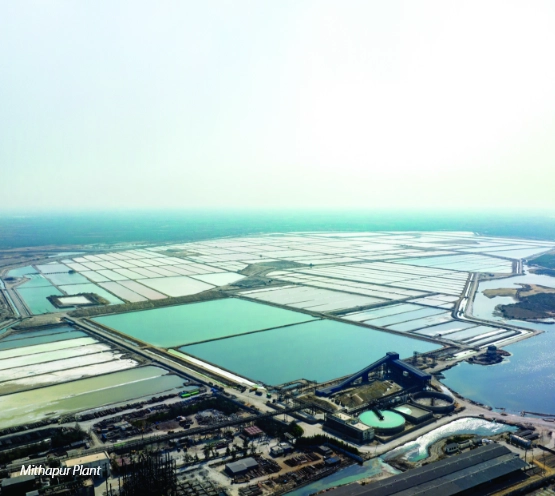Delivering to the competitive and changing needs of businesses around the world remains the focus of our Basic Chemistry Business. It is our continuous endeavour to strengthen our capabilities and competencies in this business, with a focus on technological upgradation, supply chain efficiency and quality enhancement. With state-of-the-art manufacturing facilities spread across four continents, backed by an extensive distribution network, we efficiently cater to a large customer base around the world. Our manufacturing systems, supply chain and processes are designed to promote operational and cost efficiencies.

We deliver a strong value proposition for our customers based on our core strengths, which we nurture through targeted programmes, processes and investments.
Global Market Leadership in Soda Ash
Global Market Leadership in Sodium Bicarbonate
During FY 2023-24, the soda ash markets remained oversupplied in India. On a higher base, growth across end use segments was marginal. The significant rise in import volumes resulted in lower prices. The market demand for bicarbonate, cement and other halogen products remained healthy. Salt demand also remained stable.
On the raw material cost front, coal prices softened during the year, relative to coke prices that led to lower input costs. After starting to ease in the first half of the fiscal, supply chain costs were again adversely impacted on account of the Red Sea crisis, causing delays in supplies and increases in freight costs. Lower availability of raw salt due to bittern dilution required securitisation of salt from external sources, which further increased the production cost.
Expanding Market Presence in Bicarbonate:
With increased production, we are working on further improving our market footprint across the regions and developing new application areas, e.g. for Flue Gas Desulfurisation. This emerging application not only expands the market for Bicarb but also helps in reducing pollution. We are engaging with various thermal power plants to assist in this endeavour.
Sales process enhancement for key and global soda ash customers:
We are consciously aligning with our key customers on their sustainability journey, not just optimising Scope 3 emissions but also co-developing eco-friendly products. For example, we are working with several large detergent makers on a novel bio-based surfactant. Besides this, we continuously work with our key accounts to improve the efficiency and speed of transactions for an improved customer experience, e.g. automating order process and shipment tracking through automated process (Saarthi).
Given the macro environment and our strategic focus, we have identified the following areas for driving our onward growth journey in this business:
The global challenges and complexities related to supply chain and logistics necessitate sustained investments in impactful solutions to streamline deliveries. During the year, we rolled out an important initiative – ‘Saarthi’, as part of our new Integrated Logistics Management System (ILMS). The customer-centric initiative is aimed at enabling effective visualisation, tracking and management of all inbound and outbound despatches from a centralised platform.
Despite continuing volatility and high energy prices, our UK operations in salt and sodium bicarbonate continued to deliver during the year. Demand for soda ash declined by 15% in UK due to weak economy and deterioration in the business environment in UK towards the end of the year.
Kenya business performance during the year remained stable. Fulfilling customer demand across markets was an area of focus given supply chain challenges during the year.
Our USA plant produces natural soda ash from mined trona. Impurities that are dissolved in the liquor during the process are purged to achieve product purity. The purged liquor ends up in evaporation ponds and precipitates out as sodium carbonate decahydrate (deca).
The adoption of the Pond Deca Recovery (PDR) process is enabling us to harvest, stack, melt and send back the filled deca to the processing plants as a source of soda ash liquor makeup. This liquor helps offset the declining soda ash to ore ratios, experienced over the past decade due to increasing levels of insolubles in the mined trona. This further helps minimise the production curtailment caused by lack of liquor.
Highest
cubic yards (cy) of deca harvest
Saving of
of soda ash (since calcination is not required for recovered deca)
Creation of
gals of water capacity in evaporation ponds
(During FY 2023-24)
Reduction of
MT of CO2 emission (Scope 1 and 2)
